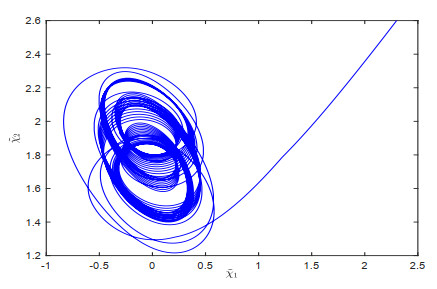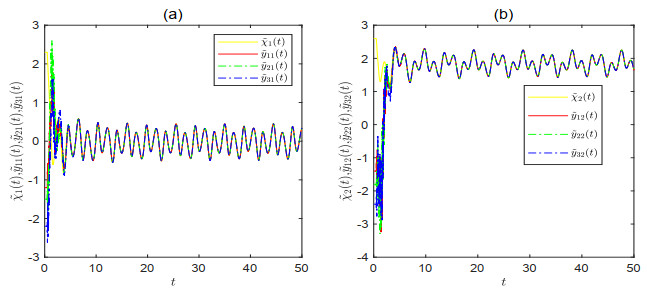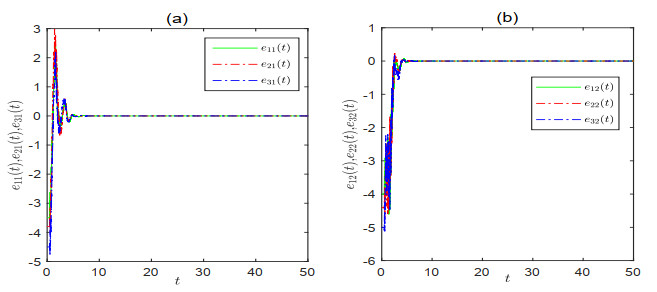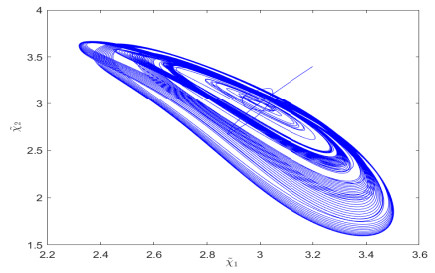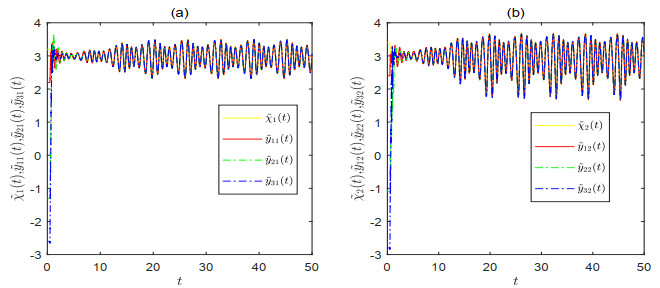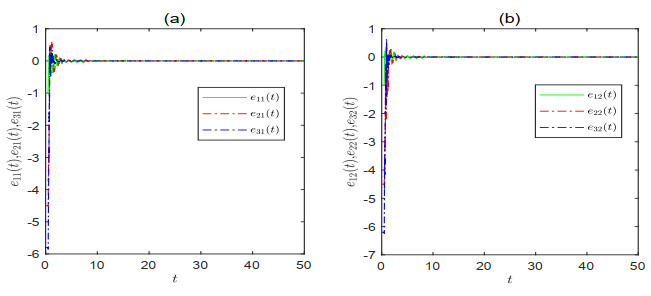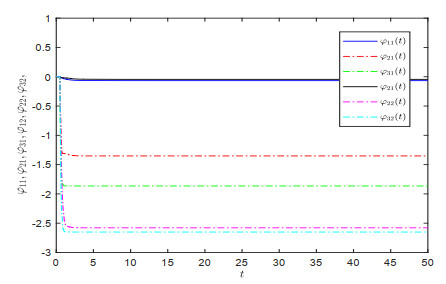1.
Introduction
Neural networks (NNs) are computational models that represent the information processing aspect of the human brain's neural network. NNs have been the focus of extensive studies across various domains in recent decades, including but not limited to automatic control [1], transmission of biological information [2], medical image analysis [3], system identification [4], and associate memory [5]. Synchronization is an essential tool for secure communication and biocomputing. It is the process of maintaining consistency in a system's dynamic signals as time passes. Synchronization, a common collective behavior, has emerged as a significant concern in the field of NNs. Researchers have developed various synchronization approaches, including pinning synchronization [6], finite time synchronization [7], and exponential synchronization [8]. In contrast to solitary NNs, coupled NNs (CNNs) exhibit more intricate and imperceptible behaviors. In recent years, researchers have made considerable progress in studying synchronization of CNNs [9,10,11,12].
Due to the limitations caused by the speed at which signals may travel, specifically the speed at which neuron amplifiers in NNs can switch and transmit, the system trajectory is contingent not only on the previous state but also on the current one. The delay category, also known as neutral-type delay, has the potential to induce instability or other undesirable dynamic behaviors [13,14,15]. Furthermore, the time delays observed in CNNs may be subject to random occurrences due to the temporal signals and synaptic voltage fluctuations transmitted by the transmitters. This can result in extremely large time delay values, despite the extremely low probability that they will occur. A degree of conservatism results if information regarding the range of time delay variations is the only factor considered, without taking their probability into consideration. Thus, a succession of research findings concerning CNNs with probabilistic time-varying latencies are available [16,17,18]. In addition to time delay effects, real NNs are susceptible to impulsive effects when system states undergo instantaneous disturbances or abrupt state changes at specific instants. These effects can have a similar impact on systems' dynamical behaviors as time-delay effects do. Thus far, considerable interest has been devoted to the synchronization or stability of the coupled neutral NNs (CNNNs) [19,20,21] and impulsive coupled NNs (ICNNs) [22,23].
Nerve signals are conveyed through chaotic electrical pulses in biological nervous systems, which are susceptible to stochastic disturbances and random noises. Frequently used to model these stochastic factors are Gaussian white noise or Brownian motion, considered reasonable approximations. As of now, a multitude of dynamic behaviors exhibited by coupled stochastic NNs, such as synchronization and stability, have been examined through the modeling of randomness using Brownian motion [14,16,20,24,25]. Nevertheless, rare instances are not uncommon among genuine biological neurons. Neuronal impulses discharge and chemical processes in neuronal synaptic receivers generate jump-type noise [26]. Therefore, the Lévy process, which expands Brownian motion to include jump-diffusion, is a more suitable model for these circumstances compared to Brownian motion [27,28,29,30]. Notwithstanding the augmented mathematical intricacy, the findings of this study suggest that examining synchronization in impulsive coupled neutral stochastic NNs (ICNSNNs) propelled by Lévy noise is more significant.
The majority of the previously published findings on the examination of NNs synchronization necessitate the activation function to adhere to Lipschitz continuity. Nevertheless, in actual situations, the Lipschitz conditions frequently impose excessively stringent requirements, with certain conditions proving exceedingly challenging to fulfill [31]. There has been considerable scholarly activity aimed at easing restrictions on activation functions, including but not limited to one-sided Lipschitz conditions and local Lipschitz conditions [32,33,34]. Accordingly, it is critical, in light of these findings, to derive lower-limit synchronization conditions for ICNSNNs with Lévy noise.
To attain synchronization among driver-response systems, it is customary to devise control protocols that specifically target the desired control outcome. CNNs are capable of implementing a wide range of control schemes, including adaptive control [13,20], impulsive control [30,35], and event-triggered control [27,28]. It is widely acknowledged that adaptive controllers possess numerous advantages and find utility across diverse domains. Adaptive control is appealing and intriguing due to its robustness and ability to adjust autonomously in response to various updating laws, suitable for systems characterized by strong nonlinearity and discontinuity on the righthand side.
Based on the preceding discussion, we consider the problem of exponential synchronization in ICNSNNs with Lévy noise, specifically in the presence of non-Lipschitz conditions. The subsequent text provides a concise overview of the main advancements in contrast to the existing body of research.
1) Compared to earlier neutral stochastic NN models, the model in this study incorporates impulse effects and probabilistic delays into the coupled neutral stochastic NNs, making it more versatile and beneficial in engineering practice.
2) The requirements necessary for synchronization analysis, which do not need Lipschitz conditions, have been created, therefore relaxing the limitations imposed by Lipschitz conditions.
3) Due to the lack of satisfaction of the chain rule by the Itô-type stochastic integral, the Dini differential method [16,22,23,35] presents challenges in solving the proof difficulties arising from the combination of impulsive component and neutral delay. Our technique is resistant to the aforementioned limitations and can efficiently tackle these challenges.
4) Under the stochastic perturbations, impulses, and various delays, by resorting to an adaptive controller, some sufficient conditions have been established to make ICNSNNs with Lévy noise achieve exponential synchronization.
Notations: Please refer to the following Table 1 for specific symbols.
2.
Models and preliminaries
We consider the neutral NNs with probabilistic delays of the form
where the variable ˜x(t)∈Rn reflects the state of neutral NNs that are connected to n neurons, and ˜H(˜x(t))∈Rn is the activation function of the neurons. G(t) is time-varying delay and satisfies conditions ˜G≥G(t)≥0 and 1>ˉG≥˙G(t). A is the neutral parameter matrix. B=diag(b1,b2,…,bn)>0. ˜E∈Rn. The connection weight matrix is denoted as C, whereas the delay connection weight matrix is denoted as D. The delay P(t) in system (2.1) is bounded and meets condition 0≤P(t)≤˜P2. Practically, there is a constant ˜P1 that satisfies 0≤˜P1≤˜P2. Moreover, P(t) assumes values within the intervals [0,˜P1] and (˜P1,˜P2] with a specific probability, as determined by its probability distribution, i.e., P{P(t)∈[0,˜P1]}=K0 and P{P(t)∈(˜P1,˜P2]}=1−K0, 0≤K0≤1.
Then
where Pk(t) satisfies 1>¯Pk≥˙Pk(t),k=1,2. The stochastic variable K(t) follows a Bernoulli distribution, denoted by P{K(t)=1}=P{P(t)∈[0,˜P1]} and P{K(t)=0}=P{P(t)∈(˜P1,˜P2]}. Then
By utilizing the new functions P1(t) and P2(t), together with the stochastic variables K(t), system (2.1) may be reformulated as
The system (2.2) is considered the drive system, with the state variable represented as ˜χ(t). The response system, on the other hand, is described by the following ICNSNN, with the state variable denoted as ˜yk(t). ek(t)=˜yk(t)−˜χ(t) specifies the following error vector:
In system (2.3), the control input vector, denoted as Ψk=(φk1,φk2,…,φkn)T∈Rn, k=1,...,N, represents the control inputs for a system. ˜ϱ>0 is coupling strength. The configuration matrix O={okj}N×N denotes the topological structure of systems. A connection from node k to j is defined as okj>0, otherwise okj=0. Additionally, okk=−N∑j=1,j≠kokj. The positive definite diagonal matrix Υ represents the internal connection strength between two interconnected NNs. ek(σl)=ek(σ+l)=limt→σ+lek(t) and ek(σ−l)=limt→σ−lek(t). ˜Jl(⋅,⋅)∈Rn. The impulsive time instants, denoted as σl, follow the conditions 0=σ0<σ1<σ2<⋯<σl<⋯, and limk→∞σl=∞. μ:Rn×Rn×Rn×Rn→Rn×n and q:Rn×Rn×Rn×Rn×V→Rn indicate Lévy noise intensity functions. A vector Brownian motion is denoted by ω(t), which is defined on the probability space (Ω,F,{Ft}t≥0,P), where {Ft}t≥0 meets the standard conditions. N(dt,dν) is a Poisson counting measure utilizing a characteristic measure π on a measurable subset V of R, whereas N(t,ν) represents a Poisson process. ˜N(dt,dν)=N(dt,dν)−π(dν)dt. The research operates under the assumption that stochastic processes ω and N are independent.
According to systems (2.2) and (2.3) and the quality of matrix O,
the error dynamics system can be obtained such that
in which H(ek(t))=˜H(˜yk(t))−˜H(˜χ(t)), H(ek(t−P1(t)))=˜H(˜yk(t−P1(t)))−˜H(˜χ(t−P1(t))), and H(ek(t−P2(t)))=˜H(˜yk(t−P2(t)))−˜H(˜χ(t−P2(t))), where ˜G0=max(˜G,˜P2). To establish synchronization, we assume control is defined as
where ℵ represents a nonnegative real number. The adaptive feedback gain is denoted as φk(t)=diag(φk1(t),φk2(t),...,φkn(t))(k=1,...,N).
To determine the synchronization requirements for systems (2.2) and (2.3), we provide the following assumptions.
A1 There is a constant ϱ>0 that fulfills
for ∀θ1,θ2∈Rn, ˜H(0)=0, where ϖ(⋅):R+→R+ is a concave increasing continuous function with ϖ(0)=0 and ∫10duϖ(u)=∞. Additionally, it is supposed that there exist a positive constant ϖ0 and a nonnegative function κ(t) with finite upper bound, such that
for ∀x≥0. Here, κ(t) meets ∫t0exp(ϑs)κ(s)ds<∞ for ∀ϑ>0.
A2 There exist constants Λ1>0, Λ2>0, Λ3>0, Γ1>0, Γ2>0, and Γ3>0 such that
and
hold for ∀θ1,θ2,θ3,θ4∈Rn. In addition, μ(0,0,0)=0 and q(0,0,0,0)=0.
A3 There exists a constant ς∈(0,1), which ensures that ρ(A) fulfills ρ(A)≤ς.
A4 The function ˜Jl(⋅,⋅) is assumed to meet the specified conditions.
where Ξl>0.
Remark 2.1. If ϖ(x)=x, then the Lipschitz criteria are satisfied, indicating that the assumption A1 is less stringent than the prerequisite of the Lipschitz continuity. Certain activation functions do not meet the criteria for Lipschitz continuity, yet they do exhibit non-Lipschitz continuity in practical applications. For example, if we are examining a function ˜H(x)=xsinx that fails to meet the criteria of Lipschitz continuity, we may construct the concave nondecreasing function
for small enough ϵ∈(0,1)[36], so that ˜H(x) encounters the assumption A1.
According to the literature [36,37,38], for any initial value {ek(ϵ):−˜G0≤ϵ≤0}=ϕ0k∈L2F0([−˜G0,0];Rn), the assumptions A1-A4 are believed to demonstrate that the solution symbolized by ek(t,ϕ0k) on t≥0 to the system (2.4) is both existent and unique. Evidently, the system (2.4) allows for ek(t,0)=0. The expressions ek(t,ϕ0k), ek(t−G(t)), ek(t−P1(t)), and ek(t−P2(t)) will be referred to as ek(t), ekG(t), ekP1(t), and ekP2(t), respectively, for simplicity.
Lemma 2.1. [30,39] Consider the function δ(t), which is piecewise continuous and nonnegative. It fulfills the condition
where ti are the points of discontinuity of the first type for δ(t). Additionally, we have ˜λ1≥0, ˜λ2≥0, ˜λ3≥0. Then, for ti<t≤ti+1,
Here, the notation i(t0,t) signifies the number of points ti that lie inside the interval [t0,t).
Definition 2.1. [20] The drive system (2.2) and the response system (2.3) are considered to be exponentially synchronized in mean square (ESMS) if the error system (2.4) is exponentially stable in mean square, meaning that for all ϕ0k∈L2F0([−˜G0,0];Rn),
3.
Exponential synchronization analysis
This section will provide the general requirements for the ESMS in systems (2.2) and (2.3) based on the assumptions A1–A4 mentioned above.
Theorem 3.1. Assume that conditions A1–A4 are satisfied. If
where
then when the adaptive controller (2.5) with update rule
is applied, where υkj>0,k=1,...,N,j=1,2,…,n, the systems (2.3) and (2.2) are ESMS.
Proof. Define
By adopting the general Itˆo's formula [40] for the interval t∈(σl,σl+1) and doing integration on both sides from σl to t, we derive
where
Through employing Young's inequality, one may infer that
Based on the given assumptions A1, we may conclude that
and
Comparable to (3.3), it is possible to get
Besides, we have
Following the assumption A2, there exist
and
When t=σl, it produces
where ˜Ξ=maxl∈N+{1+Ξl}. By replacing (3.3)–(3.9) into (3.2) and subsequently calculating the mathematical expectation for both sides of (3.2), it yields
Therefore, for any values of t inside the interval [0,σl+1), it follows that
Since
and
it can be deduced that
In addition, employing the inequality in reference [36], it can be yielded that
and we have
where ℏ>0 is sufficiently large for ˜ℏ=ς2(1+ℏ)ℏ−1exp(ϑ˜G)<1. Then,
Thus, Lemma 2.1 subsequently results in
Based on the inequality m≤infl∈N(σl+1−σl), we ultimately get
With respect to criterion (3.1), it may be concluded that systems (2.2) and (2.3) are ESMS.
Remark 3.1. Based on our comprehension, certain current CNNN and neutral NN models [13,14,15,19,20] do not take into account the impact of impulses. This research explores a wider model by incorporating impulsive effects. The Dini differential technique[16,22,23,35] is not applicable to our primary problem since it involves a combination of neutral delay and impulsive factors, and Itô-type stochastic integrals do not adhere to the chain rule. The proof strategy outlined in Theorem 3.1 offers a method for resolving the difficulty.
Remark 3.2. Activation functions are required to provide Lipschitz continuity in several studies on the synchronization or stability of CNNs, CNNNs, and neutral NNs, as indicated by the references [13,20,22,27,35]. Theorem 3.1 provides sufficient criteria for achieving synchronization in the drive-response system without the need for the Lipschitz situation, therefore relaxing the limitations imposed by Lipschitz conditions. As a result, this study extends the current findings (see [13,20,22,27,35]).
When Lévy jump q(ek(t),ek(t−G(t)),ek(t−P1(t)),ek(t−P2(t)),ν)=0, the coupled error system (2.4) reduced to the following form:
Under these circumstances, we ascertain the subsequent outcomes.
Corollary 3.1. If conditions A1–A4 are fulfilled, for
where
then when the adaptive controller (2.5) with update rule
is applied, where υkj>0,k=1,...,N,j=1,2,…,n, the systems (2.3) and (2.2) are ESMS.
Proof. Define
Employing Theorem 3.1 readily proves the result of Corollary 3.2, hence the proof is omitted in this context.
4.
Numerical simulations
This section presents numerical simulations to demonstrate the efficacy of our suggested strategy.
Example 4.1. Consider the following two-dimensional neutral NNs with probabilistic delays, where
˜χ(t)=(˜χ1(t),˜χ2(t))T, P{K(t)=0}=0.2, E=[0.1,0.1]T. The initial values are ˜χ(t)=[2.3,2.6]T. The parameters of the corresponding response system could be expressed as follows.
˜yk(t)=(˜yk1(t),˜yk2(t))T. ˜y1(t)=[−1.2,−1.4]T, ˜y2(t)=[−1.5,−1.8]T, ˜y3(t)=[−2.2,−2.4]T. φkj(t)=0,k=1,2,3,j=1,2. ϱ=0.5. The approaches provided in references [13,14,15,19,20] are not applicable to this particular instance. Verifying that the parameters in Example 4.1 fulfill the constraints of Theorem 3.1 is straightforward. Consequently, Theorem 3.1 may be utilized to establish that the response system (2.3) should be considered ESMS in theoretical analysis, together with the driving system (2.2). The simulated findings depicted in Figures 1–4 unequivocally validate our conclusion. We can find that the error systems in Figure 3 (a)–(b) converge to zero as time progresses. Figure 4 depicts the evolutionary trajectory of the adaptive feedback gain φkj(t)(k=1,2,3,j=1,2).
Example 4.2. Consider the following two-dimensional neutral NNs with probabilistic delays, where
˜χ(t)=(˜χ1(t),˜χ2(t))T, P{K(t)=0}=0.2, E=[0.1,0.1]T. The initial values are ˜χ(t)=[3.2,3.4]T. The parameters of the corresponding response system can be given as
k=1,2,3. ˜yk(t)=(˜yk1(t),˜yk2(t))T. ˜y1(t)=[2.2,2.4]T, ˜y2(t)=[−1.3,−1.1]T, ˜y3(t)=[−2.6,−2.8]T. φkj(t)=0,k=1,2,3,j=1,2. ϱ=0.5. By Remark 2.1, the activation function ˜H(⋅) in this instance does not meet the Lipschitz continuity. When ϵ=0.001, ϖ0=13, and κ(t)=exp(−2ϑt) are used, then the parameters in this example fulfill the circumstances of Theorem 3.1, implying that the systems (2.2) and (2.3) should be ESMS in the theoretical analysis. Figures 5–8 display the results of the simulation, which amply supports our conclusion. Figure 6 shows the trajectories of the system (2.2) and the system (2.3) among them, and it is evident that as time goes on, their trajectories become consistent. The error's trajectory converges to zero, as illustrated in Figure 7. Figure 8 illustrates the evolutionary trajectory of the feedback gain φkj(t)(k=1,2,3,j=1,2).
5.
Conclusions
Through adaptive controller, we address the problem of exponential synchronization in ICNSNNs with Lévy noise and probabilistic time delays in cases where the conditions are non-Lipschitz. We additionally discover sufficient criteria for achieving ESMS. In this research, we enhance the practicality of the examined model by incorporating impulse and probabilistic time-varying delays in coupled neutral stochastic NNs, as compared to previous findings[13,14,15,19,20]. The activation function's Lipschitz continuity is not necessary for our investigation, suggesting that our criteria acquired are less limiting than existing ones and can be used in a broader range of situations. Furthermore, the findings of this study propose an approach to the challenge of analyzing synchronization, which arises from the presence of both a neutral delay term and an impulse term. Finally, we present two numerical illustrations that confirm the theoretical discoveries.
In the non-Lipschitz case, developing the discriminant criteria for the exponential synchronization of ICNSNNs with Lévy noise is still a challenging issue. In addition, more discussion is required on the relaxation of the time delay condition. Lately, there has been a significant focus on the dynamic characteristics of systems that utilize event-triggered control and sliding-mode control. This is evident in the relevant literature [41,42,43,44,45]. Such issues deserve extra investigation and analysis.
Author contributions
S. M.: Conceptualization; S. M. and JM. L.: Writing-original draft; S. M. and Q. L.: Writing-review & editing; JM. L. and RN. L.: Visualization. All authors have read and agreed to the published version of the manuscript.
Use of AI tools declaration
The authors declare they have not used Artificial Intelligence (AI) tools in the creation of this article.
Acknowledgments
The work was supported in part by the Fundamental Research Funds for the Central Universities, North Minzu University under Grant No.2020KYQD17, and in part by the National Natural Science Foundation of China under Grant No. 12202005, and in part by the High-Level Talent Research Foundation of Anhui Agricultural University under Grant No. RC382106, and in part by the Philosophy and Social Science Foundation of Universities of Anhui Province under Grant No. 2023AH050970, and in part by the Nature Science Foundation of Jiangsu Province under Grant No. BK20220233, and in part by the Ningxia Outstanding Talent Support Program.
Conflict of interest
The authors declare no conflict of interest.









 DownLoad:
DownLoad:
